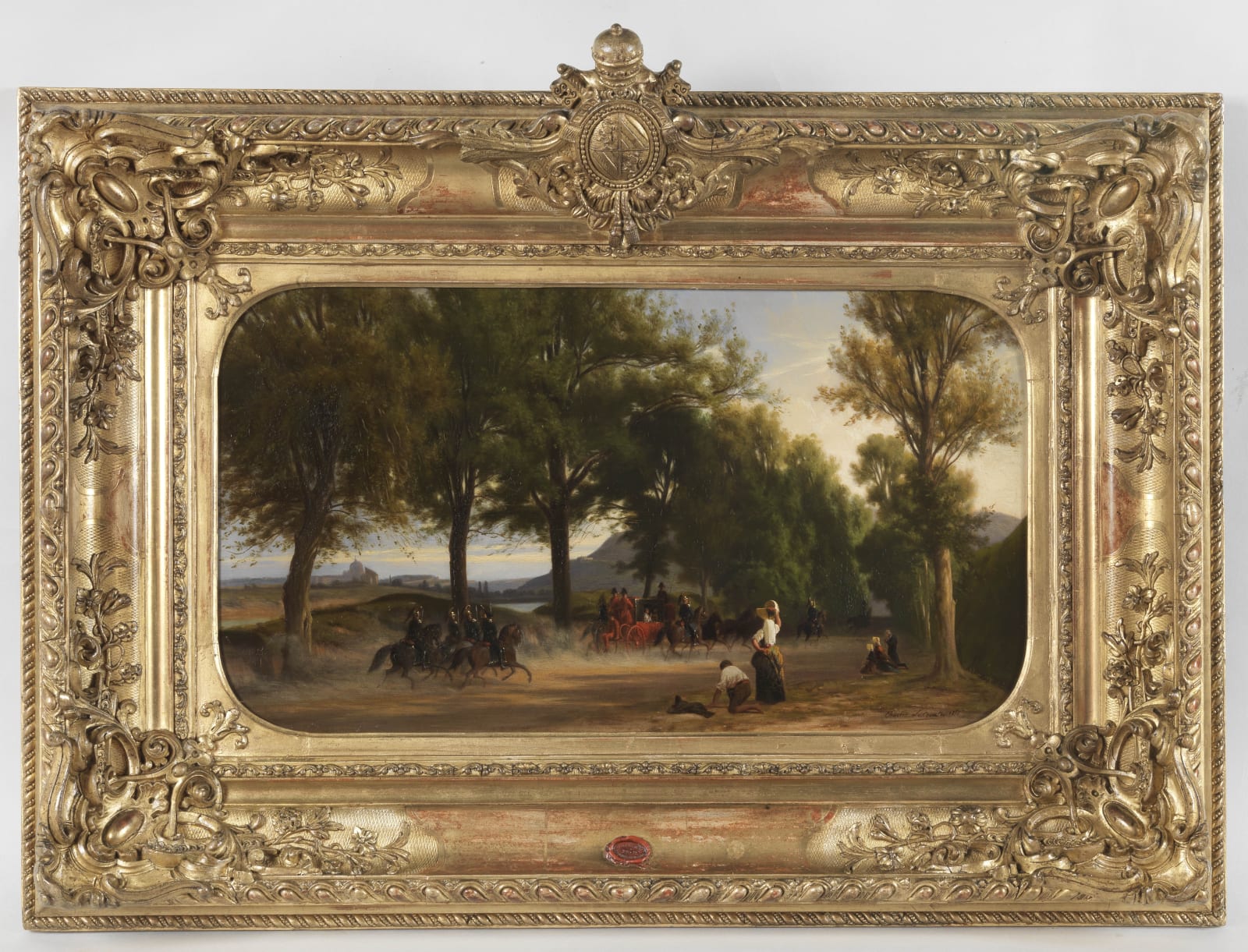Charles-Joseph LECOINTE
Provenance
Papal collection of Pope Pius IX
Galleria W. Apolloni, Rome 1974
Private collection, Rome
The painting is an excellent example of the style of this French artist who produced a substantial set of views of the papal capital and of the celebrated Campagna Romana, its surrounding countryside, during his time in Rome.
In this work the historical approach is merged unhesitatingly with the important iconographical and topographical value that the French landscape painter chose to confer on it.
The painting depicts the passage of the papal carriage, on board which we can make out the figure of Pope Pius IX as he blesses bystanders through the window.
The papal cortege proceeds along the Viale di Tor di Quinto, which stretched from the Via Flaminia along the Tiber and the foothills of Monte Mario towards the Viale Angelico and thence into the Vatican, a route which allowed travellers from the north to avoid crossing the city. In the background we can make out the dome of St. Peter's on the left, and we get a glimpse of the Tiber on the right with the hill of Monte Mario and Villa Madama overlooking it.
Lecointe arrived in Rome at a crucial moment in the city's history, with Pius IX having fled to Gaeta on 24 November 1848 and the Roman Republic having been proclaimed on 9 February 1849. So he must have witnessed the siege of the papal city by French troops in June of that same year[1].
He continued to paint views and subjects set in the Roman countryside during the years in which the Pope was in exile.
In a watercolour dated 1851, Lecointe depicted the Pope's carriage in a view of Castel Gandolfo on Pius IX's return from exile.
The date on our picture tells us that it was painted after Pius IX returned from exile, and indeed it is likely to be one of the last paintings which the artist produced before returning to Paris in 1855. Thus we may reasonably suppose that it was the artist's personal tribute to the Pontiff.
The panel is framed in a precious frame of wood and gilded pastiglia which bears the papal cartouche surmounted by the papal tiara in the centre.
Below we see the papal bull in red sealing wax with the inscription “APPARTENUTO A PIO IX DI SANTA MEMORIA” ["Formerly the property of Pius IX of blessed memory"]. The same stamp is also found on the back of the painting.
Charles-Joseph Lecointe was a French artist and landscape painter who first trained under the guiding hands of François-Édouard Picot and Claude-Félix-Theodore d’Aligny.
He won a third-class medal in 1844 and went on to win the Grand Prix de Rome in 1849, coming first in the paysage historique category. After returning to France in 1855, he was once again awarded a third-class medal. He showed his paintings at the Salons, including numerous Italian landscapes, on a number of different occasions.
He produced a substantial set of views of the most celebrated sites in Rome and the Campagna Romana in the course of his four-year term at the École de Rome in the French Academy at Villa Medici, devoting particular attention to the Castelli Romani with a clear predilection for the area around Lake Albano, including Castel Gandolfo, Marino, Ariccia, Nemi and Albano, the place he most frequently portrayed in his drawings.
Lecointe's original aim in producing sketches and drawings from life was to build up an archive of picturesque views and settings which he could then use as backgrounds for his historical paintings.
A superb collection of drawings from the painter's travelling album was displayed for the very first time in an exhibition in Palazzo Chigi in Ariccia from June to October 2006.
[1] Bibliography:
F. Petrucci (ed.); S. Marra, Vedute dei Colli Albani e di Roma. Dall’Album di viaggio di Charles Joseph Lecointe (1824 – 1866), Rome 2006.
Our gratitude to Dr. Francesco Petrucci for these indications.
JOIN OUR MAILING LIST
Subscribe to our mailing list in order to receive news on new acquisitions, exhibitions, special previews and more!
* denotes required fields
We will process the personal data you have supplied to communicate with you in accordance with our Privacy Policy. You can unsubscribe or change your preferences at any time by clicking the link in our emails.
